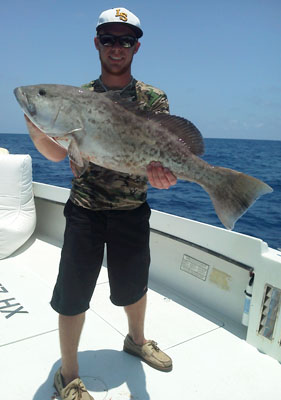Summer Brings Hot Gulf Action On Deep Water Runs
by Capt. Bill Miller

Photo by Capt. Bill Miller |
Summer's mostly calm weather provides frequent windows of opportunity for making long offshore runs to the deep Gulf of Mexico hotspots where the big fish live. The trips can cover 50-100 miles, but it's more than worth the time.
The mix of offshore sportfish species includes giant grouper of multiple species, red snapper, mangrove snapper, amberjack, sailfish, tuna, wahoo, marlin and more. You'll often encounter a diverse mix of species on any given trip, but to best focus your efforts, plan for one of two basic options – bottom fishing and trolling for pelagic.

Photo by Capt. Bill Miller |
On the Bottom: Fishing in 150 feet and deeper requires heavy tackle. Seven- to 8- foot rods on 4/0-6/0 reels loaded with at least 50-pound braid or mono is standard. Out past 150 feet, I like electric reels. They require a little more rigging for the wiring of the reels but it will save you lots of back-breaking work make reeling in fish and checking baits much easier.
Capt. Travis Palladino, a deep water expert, recommends 100-pound mono on 6/0 electric reels. Leaders made of 100- to 150-pound mono or fluorocarbon are preferred and federal regulations require circle hooks for all reef fish pursuits. I would start with a 10/0 and, if the fish are finicky, you can downsize your hook and leader.
Top dead baits include Spanish sardines, squid and my favorite – Boston mackerel. Deep water experts prefer Bostons because they are large baits with very oily flesh that releases a lot of scent into the water. If you go with live bait, big pinfish are hard to beat. Other productive live options include blue runners, big threadfins and scaled sardines.
One of the most active ways of catching deep gulf bottom fish is by working butterfly style jig on light rods specially-designed for this type of vertical presentation. With high-speed reels carrying 65-pound braid, you drop the slender lure to the bottom, jig it up 20 to 50 feet, drop it back down and repeat. Sometimes, just bouncing the jig at the bottom works, but tipping the hook with a piece of cut bait can increase your bites.
Whatever tactics you prefer, you'll want to maximize your time and trip expenses by targeting some particular bottom structure. Springs, wrecks and rocks offer the most potential, so set your course for these sites of opportunity.
Rock-N-Troll: Now, for best results on pelagic trolling trips, anglers will usually check the satellite imaging maps and look for Loop Current eddies and temperature changes to target their efforts. Billfish, tuna, wahoo and dolphin will gather most consistently in the warm water and along current seams.
Freshly rigged baits like ballyhoo, mackerel, squid and mullet work very well, but trolling lures requires less prep and maintenance, while allowing you to cover more ground. Keep a mix of lures in your spread, so you have baits that appeal to whatever rises to take a look. Some experienced billfish anglers will troll hookless lures trying tease billfish close to the boat before pitching a freshly rigged mackerel or ballyhoo back to the excited predator.
Safety note: Whether you fish the bottom or troll for pelagic, safety is always first priority when traveling far offshore. Make sure all your equipment is working properly, all of your safety gear (including a life raft) is up-to-date and you have an EPIRB that has been tested. File a float plan to let someone know where you will be and carry a satellite phone for added security – especially outside of cell phone range.
Remember, far offshore runs can give you some of your most incredible big-fish tales, but the most important thing is making it home safely to tell them.
For fishing videos, catch photos and lots of angling resources, visit www.fishingwithbillmiller.com. For fishing charters in the Tampa Bay area, call (813) 363-9927.

